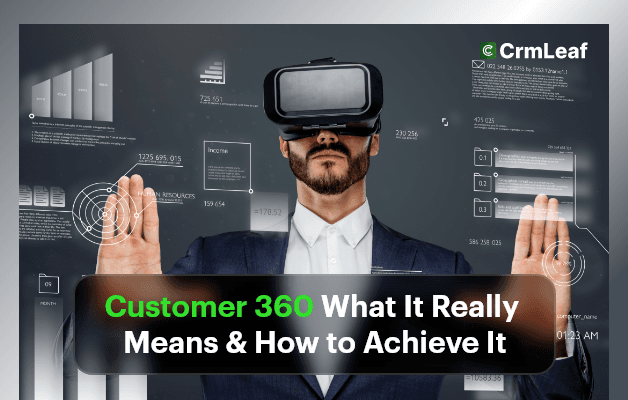Today’s customers expect more. Instant answers. Personalized service. Seamless experiences. But here’s the catch: Most businesses are still juggling fragmented systems, making it nearly impossible to truly know their customer. That’s where Customer 360 comes in.
Customer 360 means building a unified customer profile that pulls data from every touchpoint — sales, support, marketing, billing, and more. It enables your teams to see the full story behind every customer, so they can act smarter and faster.
In this post, we’ll break down:
- What Customer 360 really involves
- Why it’s critical for growing businesses
- How to build it with the right tools (hint: not spreadsheets)
- A real-world success example
Let’s dive in.

Why Customer 360 Matters to Your Business
If you’re managing sales, support, and marketing across disconnected platforms, you’re not alone. But that siloed setup is costing you — in time, revenue, and trust.
Here’s what’s at stake:
- Sales teams struggle with outdated or incomplete data
- Support reps can’t see past tickets or product issues
- Marketing targets the wrong personas with irrelevant messaging
- Finance lacks context around deals and customer behavior
Without a 360-degree customer view, it’s like driving with a blindfold.
Customer 360 solves that.
With customer data integration, all your teams operate from the same playbook. You get:
- A single customer view in real-time
- Better personalized customer experiences
- Improved cross-team collaboration
- Stronger customer retention and loyalty
Industries like retail, SaaS, manufacturing, and even education are using CRM data analytics to make smarter decisions based on real-time customer data.
Bottom line? A solid Customer 360 foundation empowers every department — and ultimately drives growth.
How to Achieve Customer 360: Best Practices & Actionable Steps
Creating a Customer 360 isn’t as simple as merging spreadsheets. It takes a system-wide strategy — and the right CRM platform.
Here’s how to get there:
1. Centralize Customer Data
- Connect your CRM, helpdesk, marketing tools, ERP, and billing systems
- Sync cross-channel data — emails, chats, calls, invoices, etc.
- Ditch manual data entry; let automation keep it clean and updated
2. Create a Unified Customer Profile
- Merge duplicate entries
- Assign unique customer IDs
- Include demographics, activity history, purchases, tickets, notes, preferences
3. Map the Customer Journey
- Identify key stages: awareness, purchase, onboarding, support
- Align internal data to each stage
- Highlight pain points and areas of drop-off
4. Enable Real-Time Data Access
- Choose a customer engagement platform that updates live
- Give every team access to the same real-time dashboard
- Set up role-based views so each user sees relevant insights
5. Make It Actionable
- Use CRM data analytics to surface trends, behavior, and churn signals
- Trigger automated workflows (follow-ups, alerts, emails) based on activity
- Prioritize leads, upsell opportunities, or risk accounts using scoring models
6. Train Your Teams
- Run regular onboarding on how to use the 360-degree customer view
- Encourage consistent data input and updates
- Create a shared culture of accountability for customer context
7. Review and Improve
- Run monthly audits of your single customer view setup
- Eliminate duplicate entries
- Add new integrations as your tech stack grows
With CRMLeaf, you get all this in one unified platform. No toggling between tabs. No guesswork.
Customer Success Story
BlueWave Technologies, a B2B SaaS company, used CRMLeaf’s Customer 360 view to unify data from sales, support, and marketing.
Before CRMLeaf, they:
- Missed key follow-ups due to scattered CRM entries
- Had marketing sending irrelevant emails to clients already onboarded
- Couldn’t get accurate churn risk metrics
After switching:
- They saw a 23% increase in upsell conversion rates
- Reduced support resolution times by 30%
- Improved NPS scores by +12 points within 3 months
Here’s how? With CRMLeaf, all teams shared a single source of truth — updated in real-time, across devices.
Key Takeaways: Your 360-Degree Advantage
Customer 360 means creating a complete, real-time, cross-functional view of every customer.
It enables personalized experiences, smarter decisions, and better retention.
Here’s what matters most:
- Stop flying blind with fragmented data
- Centralize and unify your customer data integration
- Empower every team with a 360-degree customer view
- Use tools like CRMLeaf to make it actionable, automated, and scalable
Additionally, remember that achieving Customer 360 isn’t just a tech upgrade — it’s a mindset shift. Teams must align around data transparency and customer context. With the right CRM, the transformation is not only possible, but also scalable, repeatable, and deeply impactful.
If you’re serious about customer engagement, loyalty, and growth, this isn’t optional. It’s essential.

